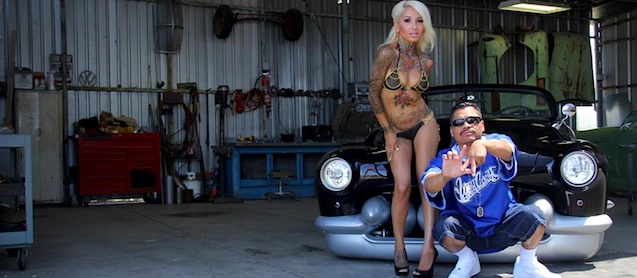MTV’s hit-series Pimp My Ride may have put West Coast Customs (WCC) on the map, but it’s been a legit automotive customization shop for well over 15 years. And while they’re known for some wild and over-the-top fabrications – like in season one when they installed a fish tank in the backseat of a Mitsubishi Mirage – WCC are still pros with loads of expert tips and tricks to share.
Take, for instance, this helpful video – in which Ish, WCC’s interior fabricator, offers a few tips on how to expertly wrap a steering wheel in leather.
Among his tips: run your material through a sewing machine without any thread in place. That way, you create an even and equally-spaced number of holes on both sides of the leather to thread by hand.

Fuuny that you put this up as I just watched this the other day. Never really got into wrapping steering wheels since there was a man down the road that did it as a hobby. Now that he is moving out of the state, he stopped by to show me some pointers and pass the work to me. Going to hav e to do my first wrap on a mid 90’s Mustang, only problem is, the steering wheel won’t come loose from column and I’ll have to wrap it while in vehicle.
It’s always harder wrapping them when they won’t come loose – but very doable. Post a picture of the finished product in our “Auto Upholstery Forum”. I’d love to check it out!
The presewing idea is a good tip. I sent a wheel off years ago, waited weeks for it’s return, and when it came back the thread was too small diameter and they had used raw edges on the leather like Ish just did. I wasn’t impressed in the least. I’ve always seen the seam line smooth where the edges of the leather were folded over and glued to make a nice clean line, and with bigger thread.
Just wondering; why does he put a small piece of fabric/leather underneath his sewing machine foot after he punctured the leather for the steering wheel?
Nice tips in this how-to btw.
He does that do next time he sews something he won’t have to hold the thread back with his hand.
must be a force of habit, because he isn’t using any thread…
I think it’s so the walking foot on the machine doesn’t come in contact with the bottom dogs. Some industrial machines really don’t like it when you see off fabric, and you generally don’t want the walking foot to get scratched/damaged by the lower half moving against it, otherwise I can scratch/scuff whatever material you’re sewing next
^that is exactly why. The dogs are pretty sharp and can easily gouge the chrome plating on the foot. Next piece of leather you send through will have scratched from the bottom of the foot
Around here we call it a run off pad, I always use one to keep my threads organized, I guess it would have the extra benefit of protecting the foot from the feed dogs. I feel like a dope, on intuition, I made my own wrap in much the same way but sewed one edge at a time with my machine. It still looked good but, I always thought it could be better. I certainly didn’t want to use a punch for all those holes.
Putting a small piece of fabric under the foot after your done sewing is for multiple reasons. The industrial machines need oil down that head on some, especially the old ones. It helps keep oil from saturating the plates and ruining fabric later on.
My former “Moto Lita”, a classic English leather steering wheel had its ends glued together and that wasn’t a very good idea, because at one time during its 35 years old service life in several cars, they left each other. So if it had been able to keep it in my cars, I would have found out to give it a fresh piece of leather with its ends better secured. Now I’m only able to cover my Brompton, folding bike